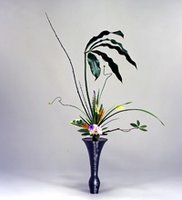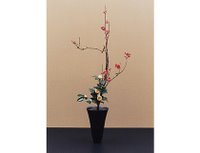 Rikka )"standing flowers"): one of the classical styles. It is very formal, structured and highly symbolic with strong vertical emphasis. The branches are treated like branches of a single plant and each branch corresponds to a part of an idealized Buddhist landscape (hill, valley, waterfall, etc.). Some of these arrangements could reach 12' high and were well suited to temple and palace interiors. Rikka style was very popular with monks and the aristocracy.
Rikka )"standing flowers"): one of the classical styles. It is very formal, structured and highly symbolic with strong vertical emphasis. The branches are treated like branches of a single plant and each branch corresponds to a part of an idealized Buddhist landscape (hill, valley, waterfall, etc.). Some of these arrangements could reach 12' high and were well suited to temple and palace interiors. Rikka style was very popular with monks and the aristocracy.Nageire ("thrown-in flowers"): This classical style became popular with people who wanted a more natural arrangement. The stems are allowed to fall naturally and so the containers for this style tend to be tall or might be designed to hang from a wall or pillar. This form is related to the flowers used for chanoya (tea ceremony). Those flowers, known as chabana, should be selected by the host who looks for the most appropriate flower for the season and then selects a vase that enhances the flower's unique qualities.
 Nageire Upright Style, J.A. Johnson
Nageire Upright Style, J.A. Johnson
Seika or Shoka ("living flowers"): Another classical style, seika has fewer rules and is less formal than rikka. In this style, more attention is placed on the way flowers occur in nature and on the beauty of the flowers themselves. These arrangements are triangular in composition and there are three main branches, although additional branches may be added as long as they do not interfere with the dominant lines of the composition. This style was popular with the late 17th century merchant class.
(Left) Shoka Shofutai, Ikenobo School
Moribana ("piled-up flowers"): In the early 20th century, Ohara Unshin devised a method of using the new floral varieties. The vase used for this style is low and shallow and the arrangements suggest natural landscapes.
Each of the styles (and there are many!) has formal guidelines that determine the placement, length and relation of the branches. The skill of the ikebana artist is in the way that he or she responds to the floral materials within those guidelines.
Moribana arrangement of silk and dried flowers with ceramic pumpkin, J.A. Johnson
:
Points to Ponder: In the tokonoma ( the alcove of a traditional Japanese house) the decorations change according to the season and occasion. The scroll, flower arrangement and any other prized object are selected to work together and enhance one another. A very important aspect of ikebana is appropriateness. The changes of the seasons and changes of life are reflected in the arrangements. Flowers may be be used at any phase of their development, from bud to fading blossom. They are also chosen for their symbolic associations.
Please respond to one of the following:
~What are some of the symbolic associations of plants and flowers that you are familiar with from your own culture?
~What are some of the ways that you or your family mark the changes of the seasons in your own home?
(Please note: all arrangements are by J.A. Johnson, unless otherwise noted.)

 Nageire Upright Style, J.A. Johnson
Nageire Upright Style, J.A. Johnson


7 Comments:
We mark the change of seasons through decoration, although I am not really capable of flower arrangement! Hallowe'en involves jack-o-lanterns, of course, (we buy a small pumpkin for each family member) and a styrofoam gravestone, and a skeleton for the door that I made out of milk cartons. Thanksgiving, we put up a "thankful tree" sketched on flattened paper bags (for the seasonal brown color!) and cut dozens of multicolored leaves, and hand them out to all the guests to write what they're thankful for on them, and tape them to the tree.
Christmas is a big deal. We always get a real tree and it has to be Fraser (Frazier?) fir; I attach trimmed branches from it to a grapevine wreath that my dad made, for the front door. And we have eleven skillion ornaments, mostly given to us by family members, so we cut the lights and drink hot chocolate and play Christmas music while we decorate, and talk about the ornaments, and DearHub and I always have to hang up the "first married Christmas" ornament together. ::blushes::
I guess, thinking about it, we bring in more of the natural world than I realized, either literally or symbolically, like with the thankful tree.
One question: I love the arrangement with the ceramic pumpkin. Is the usage of non-plant, non-vase articles in the arrangement a part of traditional ikebana, or was that your own variant?
There is a style called "morimono" that incorporates objects (things like toys or heirlooms) into the composition. I thought of the arrangement along those lines.
In some modern schools, the materials used do not even need to be organic in origin but can still be used to evoke a sense of the organic. This can go beyond using silk flowers, etc. Some artists work in metals and plastics!
In my arrangement with the pumpkin, I decided that the bamboo tray would be my vase and that allowed me to justify using much longer vertical stems. As some of the materials that I used were real and some were faux, I decided to add a faux pumpkin to balance the visual weight.
I was afraid that the shiny finish would detract from the composition. What does anyone else think?
"What are some of the ways that you or your family mark the changes of the seasons in your own home?"
For instance, we are currently moving into fall and the Thanksgiving / Christmas season. You immediately notice a huge increase in the usage of reds, yellows, oranges, and browns. Also, the smells start to tend towards cinnamon and spices, and you see gourds and other such seasonal plants displayed more than usual.
In The Art of Arranging Flowers, Shozo Sato says that "to be properly understood, Ikebana must be considered not only in relationship to architecture, but as one phase of an intricate aesthetic complex that includes all of the arts of Japan".
As we've already seen, Japanese arts embrace the changes of seasons and the passage of time.
Anyone else?
debbie: you mentioned placemats, centerpieces, etc. In Japan, along with the decorations for the New Year,the house itself is customarily renewed with new paper for the shoji and so on. The traditional home itself is in synch with the changes of the seasons.
marjie: a lot of the Japanese decorations for the New Year incorporate straw along with pine and bamboo. It sounds like some of those would be quite at home down your way!
With each season comes a set of colors to wear or decorate with. We also incorporate the weather symbols of that season with our decor, like snowflakes in winter or flowers in spring.
One relation in America to flowers is that each state has its own one to identify it. We also use flowers for special occasions and celebrations.
Bre- as you pointed out, even the colors and motifs in our wardrobes reflect the change in the seasons.
I read some place that the Japanese home is built with Summer in mind because you can always make yourself warmer in cold weather but it's tougher to cool off when it's hot and sticky. Traditional Japanese clothing seems to adhere to much the same principle.
Post a Comment
<< Home